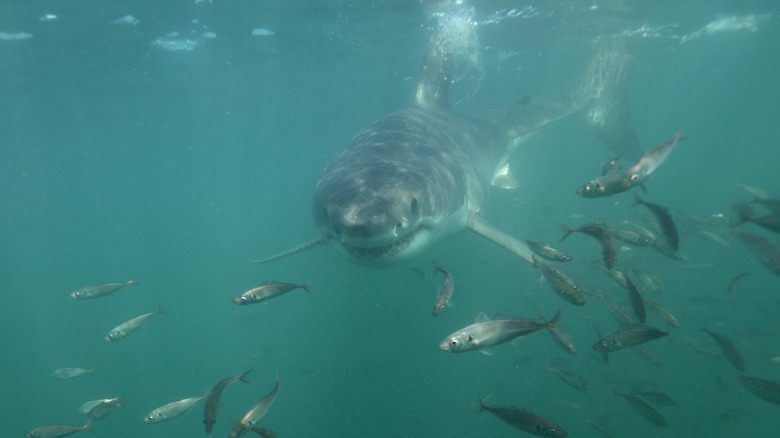Things You Didn't Know Attract Sharks While Swimming And Snorkeling
Despite what you may have seen in "Jaws" and learned from watching countless hours of shark attacks on YouTube, sharks do not intend to eat people. The majority of unprovoked shark attacks are actually a case of "mistaken identity." These ethereal predators are enticed by things you probably didn't know attract sharks, like tattoos, colorful nail polish, and uneven tans. The sharks swim in to investigate these color contrasts, mouths open for what they believe is an impending meal, only to discover that what they thought would be a tasty fish dish was a human arm or leg. No one wants to be on the other end of that!
Worried you'll be attacked while swimming on your next budget-friendly warm-weather vacation? Don't get too stressed. According to the Florida Museum of Natural History, your chance of being bitten by a shark is one in 11.5 million. You're more likely to get killed by a lightning strike (1,970 people died by lightning in the U.S. between 1959 and 2010). That said, it's best to be safe on your next visit to the world's best places to swim with sharks. So we delved deep into research from experts at the International Shark Attack File and other organizations and consulted multiple academic journals to discover the lesser-known things that attract sharks.
Tattoos
While getting a tattoo can be a trendy way to express yourself, it can also leave a person more vulnerable to a shark attack. According to a News4Jax interview with George Burress, former director of the Florida Museum of Natural History Museum and the University of Florida's International Shark File, sharks can confuse a tattoo with a fish. "Unfortunately, we've seen on more than one occasion, sharks biting a tattoo area where the tattoo is strikingly different from unusually pale skin," Burgess told News4Jax. The reason for the mistake is pretty straightforward — tattoo ink contrasts against the skin, making it appear to be prey to a shark.
While sharks boast great vision (they can see 10 times better than humans can underwater), most can't see color and struggle to discern things up close. According to an article published by The State of Hawaii, sharks are highly attracted to anything that has noticeable contrast or is reflective. Murky water doesn't seem to affect their vision too much due to a special layer called the tapetum lucidum that is present in a shark's eye. So they'll head straight for a colorful or even black-and-white tattoo if the contrast is great enough.
Yellow swimsuits
There's a reason safety gear is often brightly colored, with yellow and orange being popular choices for everything from vests to wetsuits. They're easy to spot. As mentioned earlier, sharks are probably color blind, an assumption supported in a 2020 review study by Australian Nathan Hart. This means that sharks can only see in shades of black and white. When someone sports a brightly colored swimsuit or hangs 10 on a vibrant surfboard, the shark could be drawn to these items due to the contrast, not the actual color. Again, they could mistake the color disparity for prey.
In other words, "yum-yum yellow" (so named after multiple shark attacks on U.S. Navy personnel wearing yellow life preservers in WWII) could entice sharks due to the color's juxtaposition against the dark water. Even wearing a black and white checked swimsuit could attract a shark's attention as it, too, is highly contrasting. Should you ditch the yellow polka-dot bikini? Not necessarily, say experts at the International Shark Attack File. According to them, the added benefit of being easily visible to potential rescuers is something water lovers should consider when enjoying the ocean. As mentioned earlier, the risk of being attacked by a shark is 1 in 11.5 million. One in 3.5 million people, though, are at risk of drowning.
Bright nail polish
There's something fun about painting your nails with bright-colored polish before a tropical vacation. Nothing screams "holiday" like neon pink and orange fingers and toes, right? It appears that some sharks are attracted to vibrant polish, too. Former director of the Florida Museum of Natural History Museum and the University of Florida's International Shark File George Burress told News4Jax that sharks can mistake colorful toenails for a group of fish. Eek!
In 2015, a woman was bitten twice by a bull shark at Jacksonville Beach. Both bites were on her leg, and Burress told News4Jax that the attack could be attributed to the shark's confusion over her colorful nail polish. She chose a "bluish purple" color if you're curious. According to Burress, the shark may have believed the victim's toes were a group of fish, prompting the attack. Since having a shark chomp on your tootsies is a surefire way to end a fun vacation, it's safer to stick with a more natural color.
Males
Experts at the Florida Museum of Natural History's International Shark Attack File (ISAF) found that men are likelier to be bitten by a shark than women. According to the ISAF's research, over 80% of shark bites have happened to men. These researchers claim "a gender ratio of eight men for every two women bitten." If you're a member of the male species, don't worry. The ISAF doesn't believe that sharks are actively targeting men. Instead, they say, the higher number of attacks on males has more to do with the fact that more men than women are active in aquatic sports like surfing and spearfishing.
Now for some more good news for females. While some might assume that sharks are more attracted to women, especially those who are menstruating, the ISAF found that's not the case. Their shark specialists say there's no evidence that menstruation has caused a shark attack, and they believe a woman's monthly blood flow is temporarily suspended due to water pressure while swimming. That said, it's still less risky to go swimming and diving with sharks if you aren't enduring a visit from "Aunt Flow." Regardless of your gender, be cautious when swimming in areas that are known to have shark activity.
Comfortable water temperatures
Do you prefer swimming in warm water? You aren't alone. Myriad sharks enjoy gliding through temperate seas. According to a 2023 study of bull sharks in southeast Australia published in the journal Biology, these hefty creatures were found closer to shore when the water ranged from 68 to 73 degrees Fahrenheit. Considering this is one of the most common shark species involved in worldwide attacks, it's best to be vigilant in areas they're prone to enjoy. Known as the "big three," white, bull, and tiger sharks have been responsible for 612 attacks recorded by the International Shark Attack File since 1580.
White sharks are fans of warmer water, too. A study conducted by South African researchers found an increase in shark sightings when the sea's surface temperature was between 57 and 64 degrees Fahrenheit. According to their findings, white sharks were eight times more likely to be spotted when the water was 64 degrees in Muizenberg versus the cooler 57-degree temperature. In Fish Hoek, white sharks were five times likelier to appear in 64-degree seas. If you do see a shark while snorkeling or scuba diving in warmer water, there are things you can do if you see a shark, like staying calm, acting confident, and sticking with a group.
Stormy weather
According to the aforementioned 2023 study in Biology, sharks love stormy conditions. Large waves and rain combine to create a smorgasbord of fish churned up by the rough seas. Couple this with poor visibility and swimmers could be at an increased risk of a bite. While we just learned that sharks have good vision, it can still be tough for them to discern between humans and prey in cloudy water.
For five and a half years, the study's researchers studied the proximity of large bull sharks to the shores of New South Wales. During this time, they discovered that sharks were more prominent after a storm dropped over 1.7 inches of rain. Large bull sharks were also found closer to shore when ocean swells measured between 5.9 and 9.1 feet. That's something to remember if you plan to charge storm swells surfing on the Australian coast. Speaking of dangerous places in Oz, this majestic country is peppered with some of the most dangerous spots to swim in the world. The takeaway? Be cautious when exploring the underwater region of any coast, especially after a big storm.
Sunburns and uneven tans
Bet you didn't know that sunburns and an uneven tan can attract sharks. The theory here goes back to the shark's monochromatic vision. Since most sharks don't see color, the contrast of a bright red burn beside white skin could entice one of these predators to swim towards what they assume might be prey. The same goes for someone sporting an uneven tan. The dark color set next to a white line from a bathing suit strap or tank top can become an intriguing juxtaposition to a hungry shark.
An article published on the Britannica website claims that sharks swimming and hunting prey in shallow water could easily mistake a tanned human foot with its pale bottom for their next meal. The good news? The article's author says these attacks are usually quick and involve only one bite. Once the shark realizes its mistake, it swims quickly away. If you get a noticeable tan or burn, it's safest to cover up when swimming in the ocean.
Fishing piers
It's easy to understand why sharks are attracted to fishing piers. These tourist hotspots essentially offer up an all-you-can-eat buffet for nearby marine creatures. Any area prone to fishing will have a similar effect. One of the main reasons for their interest? Blood. It's no secret that sharks are attracted to the metallic scent of blood. While it's a myth sharks can smell a drop of blood from miles away, they can smell the equivalency of a mere drop of blood dispersed in a small swimming pool (via BBC Science Focus Magazine).
Fishing piers act like giant take-out windows serving complimentary meals to nearby sharks. And who can blame them? Fresh bait, struggling fish, and the enticing scent of blood permeate the nearby area. All a shark has to do for a quick lunch is swim by with its mouth open. The problem is, that these hungry sharks can easily mistake a nearby body part for a fish. In 2015, two attacks happened near a fishing pier over one weekend in North Carolina's Oak Island. Stay safe by swimming away from fishing piers, especially during dawn, dusk, and night, when sharks are more active.
Jewelry
Sharks aren't picky when it comes to their favorite jewelry; they tend to like any piece that sparkles and shines. When light reflects off a piece of metal, it can appear similar to sunlight reflecting off a fish's scales. This could confuse a shark into thinking your new Rolex is its next tasty meal. Like humans, sharks have a harder time seeing when the water is murky. As mentioned earlier, they can see in dirty conditions, but a visible contrast can quickly catch a shark's eye. If you're swimming somewhere with rough waves, the glint from your jewels could attract unwanted attention.
Likewise, the sheen from a silver bracelet could be enough to cause a shark to hone in on your wrist. No wonder experts at the Florida Museum of Natural History recommend leaving jewels at home to reduce your risk of an unprovoked shark bite. If you're wearing a dive watch, researchers at the International Shark File suggest tucking it into the sleeve of your wetsuit to eliminate glean.
Sandbars and steep drop-offs
Experts at the Florida Museum of Natural History warn swimmers to be vigilant when spending time "between sandbars and steep drop-offs" as sharks are attracted to these areas. These regions are often filled with fish, making them prime hunting spots for sharks, reported The Palm Beach Post. Fish like to hang out near sandbars for a break from intense waves, shark expert and former director of the shark program at the University of Florida George Burgess told the newspaper.
Among the many creatures that frequent Florida sandbars, for instance, are crabs, baitfish, and mangrove snapper, which enjoy shelter from turbulent seas. Like fishing piers, this is another all-you-can-eat buffet situation for sharks. According to Burgess, commonly seen sharks near Florida sandbars include spinner, blacknose, and blacktips, as well as hammerheads and lemon sharks. Although it can be tempting to ogle the variety of marine life while snorkeling near a sandbar, it is safer to stick to less appealing venues for larger predators. Plus, these areas are prone to dangerous rip tides. The Global Shark Attack File echoes this advice, warning swimmers to avoid areas like sandbars and other natural formations that entice various sea creatures to feed in the area.
Dirty water
Swimming in dirty water probably doesn't top your vacation to-do list because it's, well, gross. If that wasn't motivating enough to stick to a lake or a pool, we've found a good reason to avoid splashing about in polluted seas — sharks. According to The Florida Museum of Natural History, sharks are drawn to water that's been contaminated by things like sewage. Their icky proclivities are due to their penchant for munching on fish, which are drawn to this type of water in hopes of finding a good meal. The murkier and more churned up the water, the better for fish trying to uncover a tasty treat.
Before you rest easy, thinking that you'd never swim in excrement, you may want to consider the many destinations to skip when booking a beach vacation, even in Europe. Popular towns like Mallorca in Spain and England's Devon have been bestowed black flags due to their pollution levels, some of which are attributed to sewage. Sewage isn't the only pollutant to cause dirty water that attracts sharks, however. Large rain storms can deposit everything from garbage to animal carcasses into the ocean and these, too, can encourage sharks to visit.
The mouth of a river
If you want to avoid coming face to fin with a sharp-toothed shark, don't swim near a river mouth, advise shark experts. Research conducted by professors at Australia's Macquarie University found higher incidents of attacks by great white, tiger, and bull sharks near river mouths, especially after a large rainfall. Australian researchers who tracked bull sharks between 2017 and 2023 had similar findings. They found these sharks most often between 1,575 and 2,526 feet of a river mouth (via Biology). According to Associate Professor Nathan Hart, the "big three" sharks are drawn to these areas because of their propensity for attracting fish (via Macquarie University's The Lighthouse).
After a big storm, shark prey is even easier to find in the spot where a river and ocean combine. The rain washes nutrients and other organisms into the area, becoming more concentrated in the river mouth. This place now offers a tempting potpourri of food to attract multiple local fish. With so many creatures swimming around, it's no wonder sharks rush in for an easy meal.
Low-light conditions
Not interested in becoming dinner for a bull shark? You can take some easy precautions, like staying out of the water at night. Sharks are attracted to areas closer to shore at this time. Authors of the 2023 Australian study in Biology warn swimmers in southeast Australia to avoid swimming between 12 and 4 p.m. and during any "low light period." Their research found a higher prevalence of these large creatures roaming near the shore between 6 p.m. and 1 a.m.
The Florida Museum of Natural History offers similar advice to swimmers, divers, snorkelers, and other watersport participants. The museum's experts say it's best to stay on land during the darker hours found at dawn, dusk, and nighttime. This is when sharks are most active, following their prey closer to shore to feed. A lack of light at this time also means sharks will struggle even more to see, which means they could more easily mistake humans for a school of fish or a seal. As reported by CNN, sharks attack more often at night, so it's best to head to dry land before the sun sets.
Florida
Of the 69 unprovoked shark attacks reported to the International Shark File in 2023, 36 happened in the United States. This number earned the U.S. the top spot on the list of most unprovoked bites, above Australia, which had 15. Once again, Florida led the other states with 44 percent of the country's shark bites occurring within its borders. A total of 16 shark bites occurred here in 2023. While this number was lower than it has been in earlier years (Florida previously averaged 19 bites over five years), there's something about the Sunshine State that sharks seem to love.
The Daytona Beach News-Journal claims the number of attacks may have something to do with the large number of visitors spending a lot of time at the beach. "More people means better odds of someone getting hurt," they report. The East Coast's Volusia County is home to New Smyrna Beach and Daytona Beach. Both fabulous destinations for beach lovers, this area has earned the moniker, "Shark Bite Capital of the World."
The reason it's so attractive to sharks is due to its big swells and high population of fish like mullet and menhaden (via Business Insider). If you're thinking about avoiding Florida's sharks by hopping on a puddle jumper to the nearby Bahamanian islands, be wary. In addition to the Bahamas' current Level 2 travel advisory due to high levels of crime, it is also home to West End, the most dangerous, shark-infested beach in the Caribbean.














